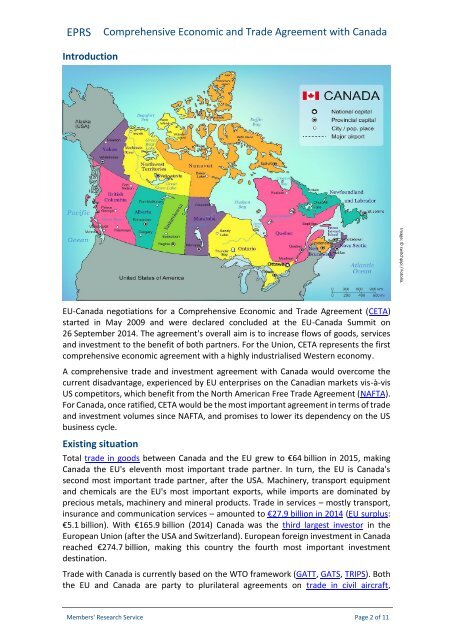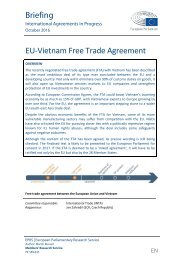Comprehensive Economic and Trade Agreement (CETA) with Canada
2iQ3UOo
2iQ3UOo
You also want an ePaper? Increase the reach of your titles
YUMPU automatically turns print PDFs into web optimized ePapers that Google loves.
EPRS<br />
<strong>Comprehensive</strong> <strong>Economic</strong> <strong>and</strong> <strong>Trade</strong> <strong>Agreement</strong> <strong>with</strong> <strong>Canada</strong><br />
Introduction<br />
Image: © switchpipi / Fotolia.<br />
EU-<strong>Canada</strong> negotiations for a <strong>Comprehensive</strong> <strong>Economic</strong> <strong>and</strong> <strong>Trade</strong> <strong>Agreement</strong> ( <strong>CETA</strong>)<br />
started in May 2009 <strong>and</strong> were declared concluded at the EU-<strong>Canada</strong> Summit on<br />
26 September 2014. The agreement's overall aim is to increase flows of goods, services<br />
<strong>and</strong> investment to the benefit of both partners. For the Union, <strong>CETA</strong> represents the first<br />
comprehensive economic agreement <strong>with</strong> a highly industrialised Western economy.<br />
A comprehensive trade <strong>and</strong> investment agreement <strong>with</strong> <strong>Canada</strong> would overcome the<br />
current disadvantage, experienced by EU enterprises on the Canadian markets vis-à-vis<br />
US competitors, which benefit from the North American Free <strong>Trade</strong> <strong>Agreement</strong> (NAFTA).<br />
For <strong>Canada</strong>, once ratified, <strong>CETA</strong> would be the most important agreement in terms of trade<br />
<strong>and</strong> investment volumes since NAFTA, <strong>and</strong> promises to lower its dependency on the US<br />
business cycle.<br />
Existing situation<br />
Total trade in goods between <strong>Canada</strong> <strong>and</strong> the EU grew to €64 billion in 2015, making<br />
<strong>Canada</strong> the EU's eleventh most important trade partner. In turn, the EU is <strong>Canada</strong>'s<br />
second most important trade partner, after the USA. Machinery, transport equipment<br />
<strong>and</strong> chemicals are the EU's most important exports, while imports are dominated by<br />
precious metals, machinery <strong>and</strong> mineral products. <strong>Trade</strong> in services – mostly transport,<br />
insurance <strong>and</strong> communication services – amounted to €27.9 billion in 2014 (EU surplus:<br />
€5.1 billion). With €165.9 billion (2014) <strong>Canada</strong> was the third largest investor in the<br />
European Union (after the USA <strong>and</strong> Switzerl<strong>and</strong>). European foreign investment in <strong>Canada</strong><br />
reached €274.7 billion, making this country the fourth most important investment<br />
destination.<br />
<strong>Trade</strong> <strong>with</strong> <strong>Canada</strong> is currently based on the WTO framework (GATT, GATS, TRIPS). Both<br />
the EU <strong>and</strong> <strong>Canada</strong> are party to plurilateral agreements on trade in civil aircraft,<br />
Members' Research Service Page 2 of 11




